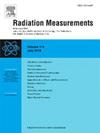Applying a bicorrelation method for determining the angular correlation of gamma-rays using gamma–gamma coincidence
IF 2.2
3区 物理与天体物理
Q2 NUCLEAR SCIENCE & TECHNOLOGY
引用次数: 0
Abstract
The angular correlation between two coincident gamma ray pairs from 152Eu was found at multiple distances (1–13 cm) and detector orientations (180-30°). This phenomenon was extrapolated from calculated bicorrelation coefficients observed from the 344 keV + 778 keV coincident gamma rays from decay and the 121 keV + 244 keV coincident gamma rays from electron capture. The angular correlation for the electron capture gamma ray pair was determined to be higher when the detectors were at or close to 180 ° (facing each other) whereas the angular correlation for the decay gamma ray pair was higher when the angle between detectors approached 90° (perpendicular). The results of this work highlight the utility of tuning measurements utilizing a radioactive species’ angular correlation of coincidence gamma ray pairs to maximize the counting statistics for specific radionuclides such as those observed through neutron activation analysis.
应用双相关法利用伽马-伽马重合来确定伽马射线的角相关性
在多个距离(1 ~ 13 cm)和探测器方向(180 ~ 30°)上发现了来自152Eu的两个重合伽马射线对之间的角相关性。这一现象是根据β -衰变产生的344 keV + 778 keV的伽马射线和电子捕获产生的121 keV + 244 keV的伽马射线计算出的双相关系数推断出来的。当探测器处于或接近180°(彼此朝向)时,电子捕获伽马射线对的角相关性较高,而当探测器之间的角度接近90°(垂直)时,β衰变伽马射线对的角相关性较高。这项工作的结果强调了利用放射性物质的重合伽马射线对的角相关性进行调谐测量的效用,以最大限度地提高特定放射性核素的计数统计,例如通过中子活化分析观察到的那些。
本文章由计算机程序翻译,如有差异,请以英文原文为准。
求助全文
约1分钟内获得全文
求助全文
来源期刊

Radiation Measurements
工程技术-核科学技术
CiteScore
4.10
自引率
20.00%
发文量
116
审稿时长
48 days
期刊介绍:
The journal seeks to publish papers that present advances in the following areas: spontaneous and stimulated luminescence (including scintillating materials, thermoluminescence, and optically stimulated luminescence); electron spin resonance of natural and synthetic materials; the physics, design and performance of radiation measurements (including computational modelling such as electronic transport simulations); the novel basic aspects of radiation measurement in medical physics. Studies of energy-transfer phenomena, track physics and microdosimetry are also of interest to the journal.
Applications relevant to the journal, particularly where they present novel detection techniques, novel analytical approaches or novel materials, include: personal dosimetry (including dosimetric quantities, active/electronic and passive monitoring techniques for photon, neutron and charged-particle exposures); environmental dosimetry (including methodological advances and predictive models related to radon, but generally excluding local survey results of radon where the main aim is to establish the radiation risk to populations); cosmic and high-energy radiation measurements (including dosimetry, space radiation effects, and single event upsets); dosimetry-based archaeological and Quaternary dating; dosimetry-based approaches to thermochronometry; accident and retrospective dosimetry (including activation detectors), and dosimetry and measurements related to medical applications.
 求助内容:
求助内容: 应助结果提醒方式:
应助结果提醒方式:


